Quasicrystalline Ordering in Thin Liquid Crystal Films
Abstract
1. Introduction
2. Quasicrystalline Ordering of Shaped Particles in Thin Nematic Layers
3. Optically Induced Quasicrystalline Ordering of Particles in Thin Chiral Nematic Layers
4. Discussion
5. Conclusions
Author Contributions
Funding
Conflicts of Interest
References
- Shechtman, D.; Blech, I.; Gratias, D.; Cahn, J. Metallic Phase with Long-Range Orientational Order and No Translational Symmetry. Phys. Rev. Lett. 1951, 53, 1951. [Google Scholar] [CrossRef]
- Levine, D.; Steinhardt, P.J. Quasicrystals: A New Class of Ordered Structures. Phys. Rev. Lett. 1984, 53, 2477. [Google Scholar] [CrossRef]
- Bindi, L.; Steinhardt, P.J.; Yao, N.; Lu, P.J. Natural Quasicrystals. Science 2009, 324, 1306–1309. [Google Scholar] [CrossRef] [PubMed]
- Dzugutov, M. Formation of a dodecagonal quasicrystalline phase in a simple monatomic liquid. Phys. Rev. Lett. 1993, 70, 2924–2927. [Google Scholar] [CrossRef] [PubMed]
- Denton, A.; Loewen, H. Stability of colloidal quasicrystals. Phys. Rev. Lett. 1998, 81, 469. [Google Scholar] [CrossRef]
- Jagla, E.A. Minimum energy configurations of repelling particles in two dimensions. J. Chem. Phys. 1999, 110, 451–456. [Google Scholar] [CrossRef]
- Zeng, X.; Ungar, G.; Liu, Y.; Percec, V.; Dulcey, A.E.; Hobbs, J.K. Supramolecular dendritic liquid crystals. Nature 2004, 428, 157–160. [Google Scholar] [CrossRef] [PubMed]
- Ungar, G.; Percec, V.; Zeng, X.; Leowanawat, P. Liquid Quasicrystals. Isr. J. Chem. 2011, 51, 1206–1215. [Google Scholar] [CrossRef]
- Takano, A.; Kawashima, W.; Noro, A.; Isono, Y.; Tanaka, N.; Dotera, T.; Matsushita, Y. A mesoscopic Archimedean tiling having a new complexity in an ABC star polymer. J. Polym. Sci. Part B Polym. Phys. 2005, 43, 2427–2432. [Google Scholar] [CrossRef]
- Hayashida, K.; Dotera, T.; Takano, A.; Matsushita, Y. Polymeric Quasicrystal: Mesoscopic Quasicrystalline Tiling in ABC Star Polymers. Phys. Rev. Lett. 2007, 98, 195502. [Google Scholar] [CrossRef] [PubMed]
- Talapin, D.V.; Shevchenko, E.V.; Bodnarchuk, M.I.; Ye, X.; Chen, J.; Murray, C.B. Quasicrystalline order in self-assembled binary nanoparticle superlattices. Nature 2009, 461, 964–967. [Google Scholar] [CrossRef] [PubMed]
- Lee, S.; Bluemle, M.J.; Bates, F.S. Discovery of a Frank-Kasper sigma phase in sphere-forming block copolymer melts. Science 2010, 330, 349–353. [Google Scholar] [CrossRef] [PubMed]
- Fischer, S.; Exnera, A.; Zielskea, K.; Perlichb, J.; Deloudic, S.; Steurerc, W.; Lindnerd, P.; Forstere, S. Colloidal quasicrystals with 12-fold and 18-fold diffraction symmetry. Proc. Natl. Acad. Sci. USA 2011, 108, 1810–1814. [Google Scholar] [CrossRef] [PubMed]
- Ungar, G.; Liu, Y.; Zeng, X.; Percec, V.; Cho, W.-D. Low-symmetry sphere packings of simple surfactant micelles induced by ionic sphericity. Science 2003, 299, 1208–1211. [Google Scholar] [CrossRef] [PubMed]
- Haji-Akbari, A.; Engel, M.; Keys, A.S.; Zheng, X.; Petschek, R.G.; Palffy-Muhorray, P.; Glotzer, S.C. Disordered, quasicrystalline and crystalline phases of densely packed tetrahedra. Nature 2009, 462, 773–777. [Google Scholar] [CrossRef] [PubMed]
- Dotera, T.; Oshiro, T.; Ziherl, P. Mosaic two-lengthscale quasicrystals. Nature 2014, 506, 208. [Google Scholar] [CrossRef] [PubMed]
- Dotera, T.; Bekku, S.; Ziherl, P. Bronze-mean hexagonal quasicrystal. Nat. Mater. 2017, 16, 987. [Google Scholar] [CrossRef] [PubMed]
- Ziherl, P.; Dotera, T. Soft Quasicrystals. J. Phys. Condens. Matter 2017, 24, 284101. [Google Scholar]
- Ziherl, P.; Kamien, R.D. Maximizing Entropy by Minimizing Area Towards a New Principle of Self-Organization. J. Phys. Chem. B 2001, 105, 10147. [Google Scholar] [CrossRef]
- Keys, A.S.; Glotzer, S.C. How do quasicrystals grow? Phys. Rev. Lett. 2007, 99, 235503. [Google Scholar] [CrossRef] [PubMed]
- Iacovellaa, C.R.; Keys, A.S.; Glotzer, S.C. Self-assembly of soft-matter quasicrystals and their approximants. Proc. Natl. Acad. Sci. USA 2011, 108, 20935–20940. [Google Scholar] [CrossRef] [PubMed]
- Engel, M.; Damasceno, P.F.; Phillips, C.L.; Glotzer, S.C. Computational self-assembly of a one-component icosahedral quasicrystal. Nat. Mater. 2015, 14, 109–116. [Google Scholar] [CrossRef] [PubMed]
- Lapointe, C.P.; Mason, T.G.; Smalyukh, I.I. Shape-Controlled Colloidal Interactions in Nematic Liquid Crystals. Science 2009, 326, 1083. [Google Scholar] [CrossRef] [PubMed]
- Lapointe, C.P.; Hopkins, S.; Mason, G.T.; Smalyukh, I.I. Electrically Driven Multiaxis Rotational Dynamics of Colloidal Platelets in Nematic Liquid Crystals. Phys. Rev. Lett. 2010, 105, 178301. [Google Scholar] [CrossRef] [PubMed]
- Dontabhaktuni, J.; Ravnik, M.; Žumer, S. Shape-tuning the colloidal assemblies in nematic liquid crystals. Softmatter 2012, 8, 1657–1663. [Google Scholar] [CrossRef]
- Dontabhaktuni, J.; Ravnik, M.; Žumer, S. Quasicrystalline tilings with nematic colloidal platelets. Proc. Natl. Acad. Sci. USA 2014, 111, 2464–2469. [Google Scholar] [CrossRef] [PubMed]
- Senyuk, B.; Liu, Q.; Bililign, E.; Nystrom, P.D.; Smalyukh, I.I. Geometry-guided colloidal interactions and self-tiling of elastic dipoles formed by truncated pyramid particles in liquid crystals. Phys. Rev. E 2015, 91, 040501. [Google Scholar] [CrossRef] [PubMed]
- Mikhael, J.; Roth, J.; Helden, L.; Bechinger, C. Archimedean-like tiling on decagonal quasicrystalline surfaces. Nature 2008, 454, 501. [Google Scholar] [CrossRef] [PubMed]
- Luo, D.; Du, Q.G.; Dai, H.T.; Demir, H.V.; Yang, H.Z.; Ji, W.; Sun, X.W. Strongly linearly polarized low threshold lasing of all organic photonic quasicrystals. Sci. Rep. 2012, 2, 627. [Google Scholar] [CrossRef] [PubMed]
- Tkalec, U.; Ravnik, M.; Čopar, S.; Žumer, S.; Muševič, I. Reconfigurable Knots and Links in Chiral Nematic Colloids. Science 2011, 333, 6038. [Google Scholar] [CrossRef] [PubMed]
- Roichman, Y.; Grier, D.G. Holographic assembly of quasicrystalline photonic heterostructures. Opt. Exp. 2005, 13, 5434–5439. [Google Scholar] [CrossRef]
- Ackerman, P.J.; Qi, Z.; Smalyukh, I.I. Optical generation of cyrstalline, quasicrystalline and arbitrary arrays of torons in confined cholesteric liquid crystals for patterning of optical vortices in laser beams. Phys. Rev. E 2012, 86, 021703. [Google Scholar] [CrossRef] [PubMed]
- Stark, H. Physics of colloidal dispersions in nematic liquid crystals. Phys. Rep. 2001, 351, 387–474. [Google Scholar] [CrossRef]
- Muševič, I.; Škarabot, M.; Tkalec, U.; Ravnik, M.; Žumer, S. Two-Dimensional Nematic Colloidal Crystals Self-Assembled by Topological Defects. Science 2006, 313, 954–958. [Google Scholar] [CrossRef] [PubMed]
- Ravnik, M.; Škarabot, M.; Žumer, S.; Tkalec, U.; Poberaj, I.; Babič, D.; Osterman, N.; Muševič, I. Entangled Nematic Colloidal Dimers and Wires. Phys. Rev. Lett. 2007, 99, 247801. [Google Scholar] [CrossRef] [PubMed]
- Muševič, I. Liquid Crystal Colloids; Springer: Berlin, Germany, 2017. [Google Scholar]
- Conradi, M.; Ravnik, M.; Bele, M.; Zorko, M.; Žumer, S.; Muševič, I. Janus nematic colloids. Soft Matter 2009, 5, 3905–3912. [Google Scholar] [CrossRef]
- Liu, Q.; Senyuk, B.; Tasinkevych, M.; Smalyukh, I.I. Nematilc liquid crystal boojums with handles on colloidal handlbodies. Proc. Natl. Acad. Sci. USA 2013, 110, 9231–9236. [Google Scholar] [CrossRef] [PubMed]
- Hashemi, S.M.; Jagodič, U.; Mozaffari, M.R.; Ejtehadi, M.R.; Muševič, I.; Ravnik, M. Fractal nematic colloids. Nat. Commun. 2017, 8, 14026. [Google Scholar] [CrossRef] [PubMed]
- Silvestre, M.; Tasinkevych, M. Key-lock colloids in a nematic liquid crystal. Phys. Rev. E 2017, 95, 012606. [Google Scholar] [CrossRef] [PubMed]
- Smalyukh, I.I.; Lansac, Y.; Clark, N.; Trivedi, R.P. Three-dimensional structure and multistable optical switching of triple-twisted particle-like excitations in anisotropic fluids. Nat. Mater. 2010, 9, 139–145. [Google Scholar] [CrossRef] [PubMed]
- Varanytsia, A.; Posnjak, G.; Mur, U.; Joshi, V.; Darrah, K.; Muševič, I.; Čopar, S.; Chien, L. Topology-commanded optical properties of bistable electric-field-induced torons in cholesteric bubble domains. Sci. Rep. 2017, 7, 16149. [Google Scholar] [CrossRef] [PubMed]
- Žumer, S.; Porenta, T.; Ravnik, M. Complex field-induced nematic defect structures in Laguerre-Gaussian optical tweezers. In Liquid Crystals XVI; SPIE: Bellingham, WA, USA, 2012; Volume 8475. [Google Scholar]
- Čopar, S. Topology and geometry of nematic braids. Phys. Rep. 2014, 538, 1–37. [Google Scholar] [CrossRef]
- Porenta, T.; Ravnik, M.; Žumer, S. Complex field-stabilised nematic defect structures in Laguerre-Gaussian optical tweezers. Soft Matter 2012, 8, 1865–1870. [Google Scholar] [CrossRef]
- Damasceno, P.F.; Engel, M.; Glotzer, S.C. Predictive Self-Assembly of Polyhedra into Complex Structures. Science 2012, 337, 453–457. [Google Scholar] [CrossRef] [PubMed]
- Cao, W.; Muoz, A.; Palffy-Muhoray, P.; Taheri, B. Lasing in a three-dimensional photonic crystal of the liquid crystal blue phase II. Nat. Mater. 2002, 1, 111. [Google Scholar] [CrossRef] [PubMed]
- Mowatt, C.; Morrisa, S.M.; Wilkinson, T.D.; Coles, H.J. High slope efficiency liquid crystal lasers. Appl. Phys. Lett. 2010, 97, 251109. [Google Scholar] [CrossRef]
- Gardiner, D.J.; Morris, S.M.; Hands, P.J.; Mowatt, C.; Rutledge, R.; Wilkinson, T.D.; Coles, H.J. Paintable band-edge liquid crystal lasers. Opt. Exp. 2011, 19, 2432–2439. [Google Scholar] [CrossRef] [PubMed]
- Ko, D.H.; Morris, S.M.; Lorenz, A.; Castles, F.; Butt, H.; Gardiner, D.J.; Qasim, M.M.; Wallikewitz, B.; Hands, P.J.; Wilkinson, T.D.; et al. A nano-patterned photonic crystal laser with a dye-doped liquid crystal. Appl. Phys. Lett. 2013, 103, 051101. [Google Scholar] [CrossRef]
- Stimulak, M.; Ravnik, M. Tunable photonic crystals with partial bandgaps from blue phase colloidal crystals and dielectric-doped blue phases. Soft Matter 2014, 10, 6339–6346. [Google Scholar] [CrossRef] [PubMed]
- Alpinc, J.; Stimulak, M.; Čopar, S.; Ravnik, M. Nematic liquid crystal gyroids as photonic crystals. Liq. Cryst. 2016, 43, 2320–2331. [Google Scholar]
- Humar, M.; Ravnik, M.; Pajk, S.; Muševič, I. Electrically tunable liquid crystal optical microresonators. Nat. Photonics 2009, 3, 595. [Google Scholar] [CrossRef]
- Humar, M.; Muševic, I. 3D microlasers from self-assembled cholesteric liquid-crystal microdroplets. Opt. Exp. 2010, 18, 26995–27003. [Google Scholar] [CrossRef] [PubMed]
- Peddireddy, K.; Jampani, V.S.R.; Thutupalli, S.; Herminghaus, S.; Bahr, C.; Muševič, I. Lasing and waveguiding in smectic A liquid crystal optical fibers. Opt. Exp. 2013, 21, 30233–30242. [Google Scholar] [CrossRef] [PubMed]
- Ravnik, M.; Štimulak, M.; Mur, U.; Čanula, M.; Čopar, S.; Žumer, S. Photonic crystals, light manipulation, and imaging in complex nematic structures. In Emerging Liquid Crystal Technologies XI; International Society for Optics and Photonics: Bellingham, WA, USA, 2014. [Google Scholar]
- Muševic, I. Integrated and topological liquid crystal photonics. Liq. Cryst. 2014, 41, 418–429. [Google Scholar] [CrossRef]
- Alberucci, A.; Piccardi, A.; Bortolozzo, U.; Residori, S.; Assanto, G. Nematicon all-optical control in liquid crystal light valves. Opt. Lett. 2010, 35, 390–392. [Google Scholar] [CrossRef] [PubMed]
- Hakobyan, D.; Brasselet, E. Left-handed optical radiation torque. Nat. Photonics 2014, 8, 610. [Google Scholar] [CrossRef]
- Pile, D.; Brasselet, E. Backwards torque. Nat. Photonics 2014, 8, 664. [Google Scholar] [CrossRef]
- Loussert, C.; Delabre, U.; Brasselet, E. Manipulating the Orbital Angular Momentum of Light at the Micron Scale with Nematic Disclinations in a Liquid Crystal Film. Phys. Rev. Lett. 2013, 111, 037802. [Google Scholar] [CrossRef] [PubMed]
- Čančula, M.; Ravnik, M.; Žumer, S. Generation of vector beams with liquid crystal disclination lines. Phys. Rev. E 2014, 90, 022503. [Google Scholar] [CrossRef] [PubMed]
- Kobashi, J.; Yoshida, H.; Ozaki, M. Planar optics with patterned chiral liquid crystals. Nat. Photonics 2016, 10, 389–392. [Google Scholar] [CrossRef]
- Kosa, T.; Sukhomlinova, L.; Su, L.; Taheri, B.; White, T.J.; Bunning, T.J. Light-induced liquid crystallinity. Nature 2012, 485, 347–349. [Google Scholar] [CrossRef] [PubMed]
- Yuan, Y.; Smalyukh, I.I. Topological nanocolloids with facile electric switching of plasmonic properties. Opt. Lett. 2015, 40, 5630–5633. [Google Scholar] [CrossRef] [PubMed]
- Dontabhaktuni, J.; Madduri, S.; Bregar, A.; Ravnik, M. Self-organized three dimensional quasicrystals in nematic liquid crystals. 2018; submitted. [Google Scholar]
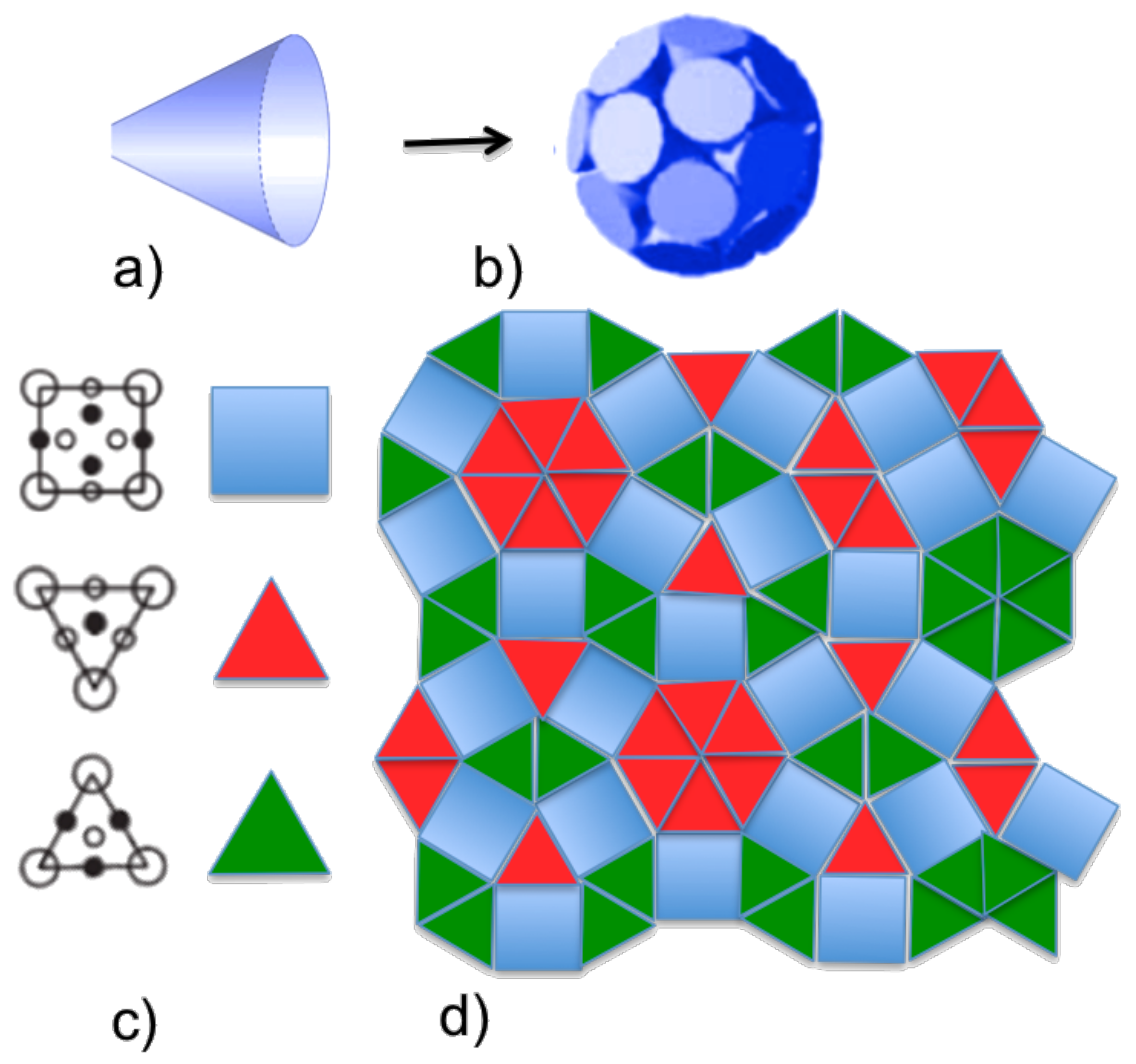
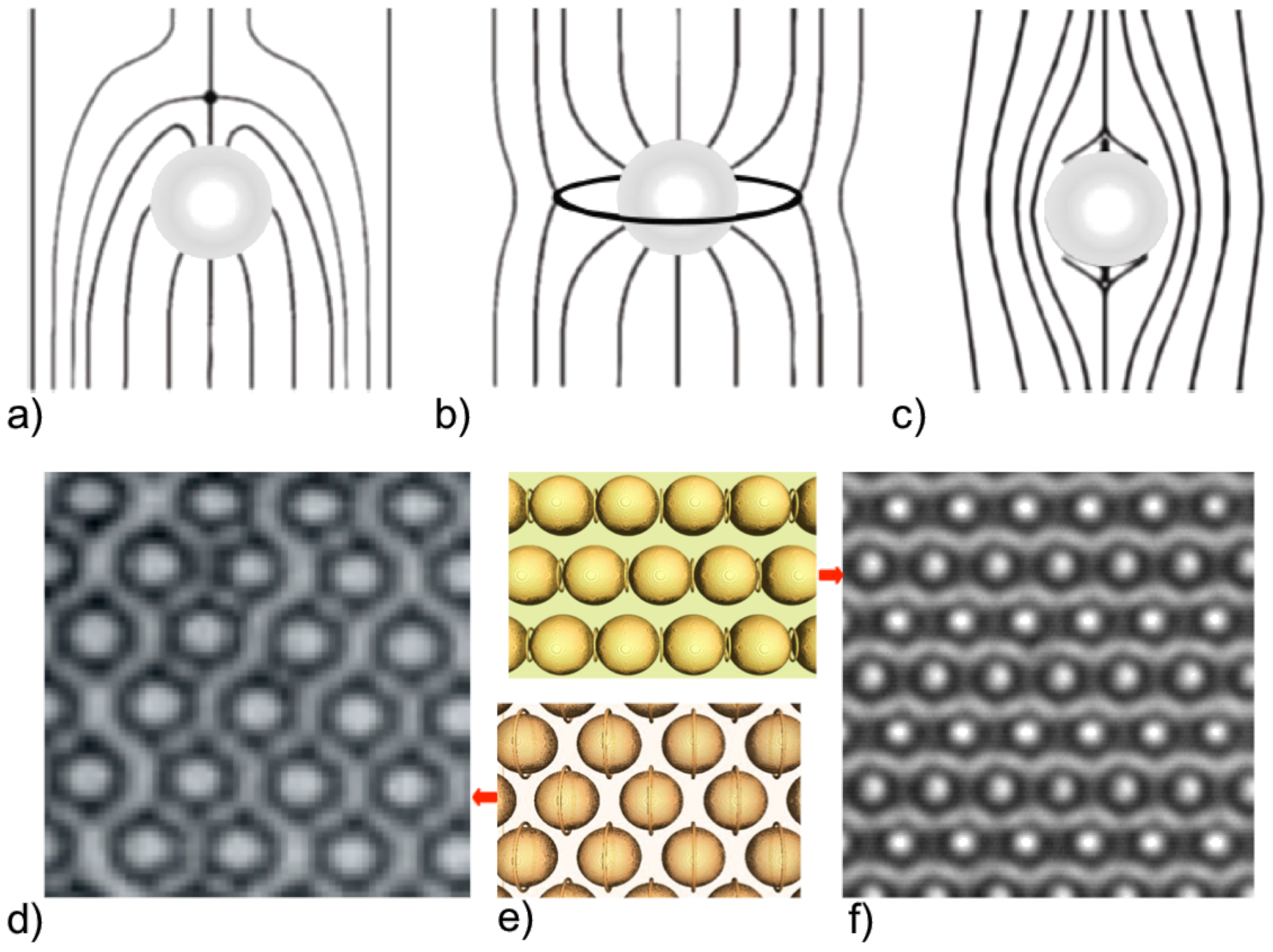
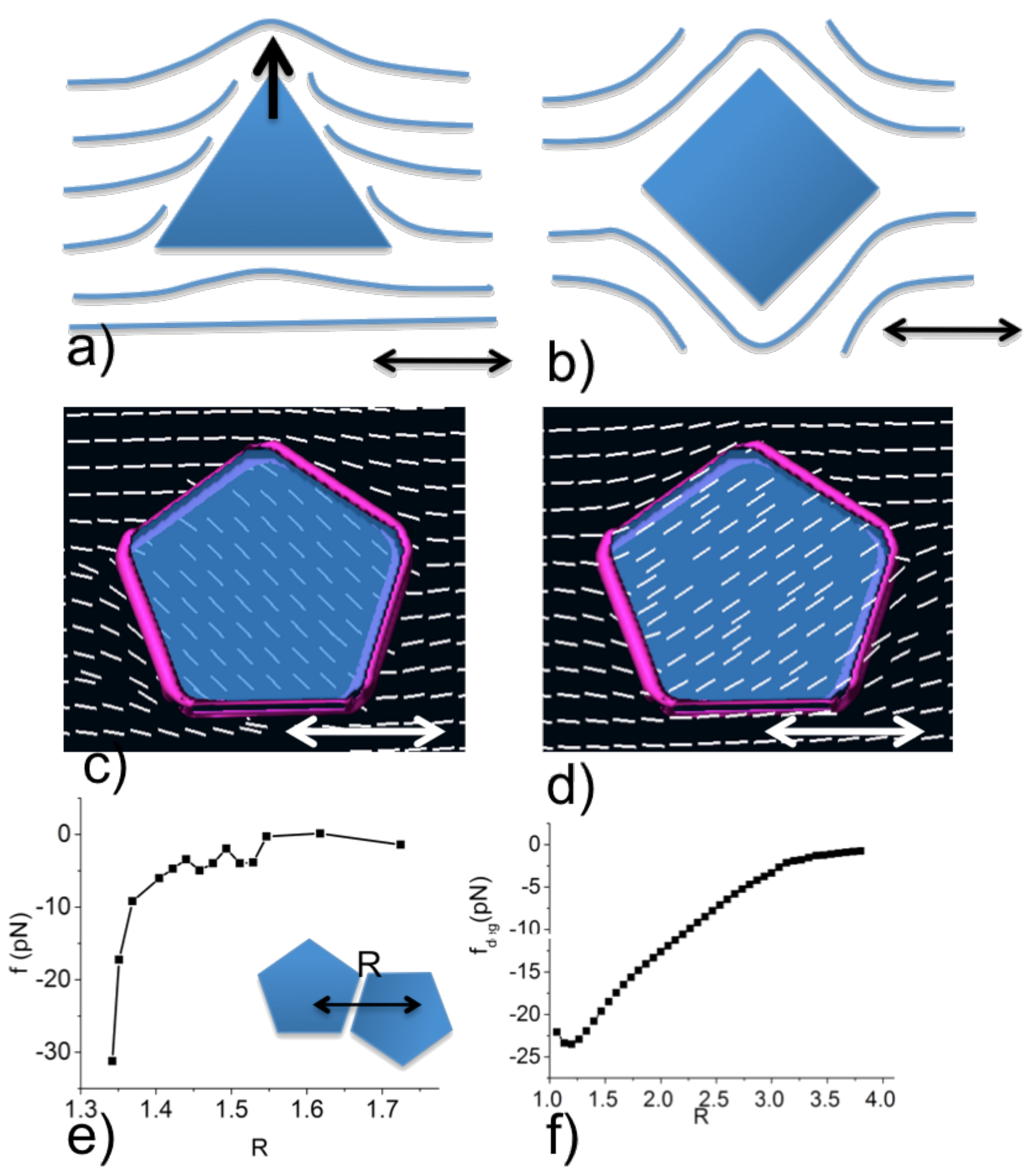
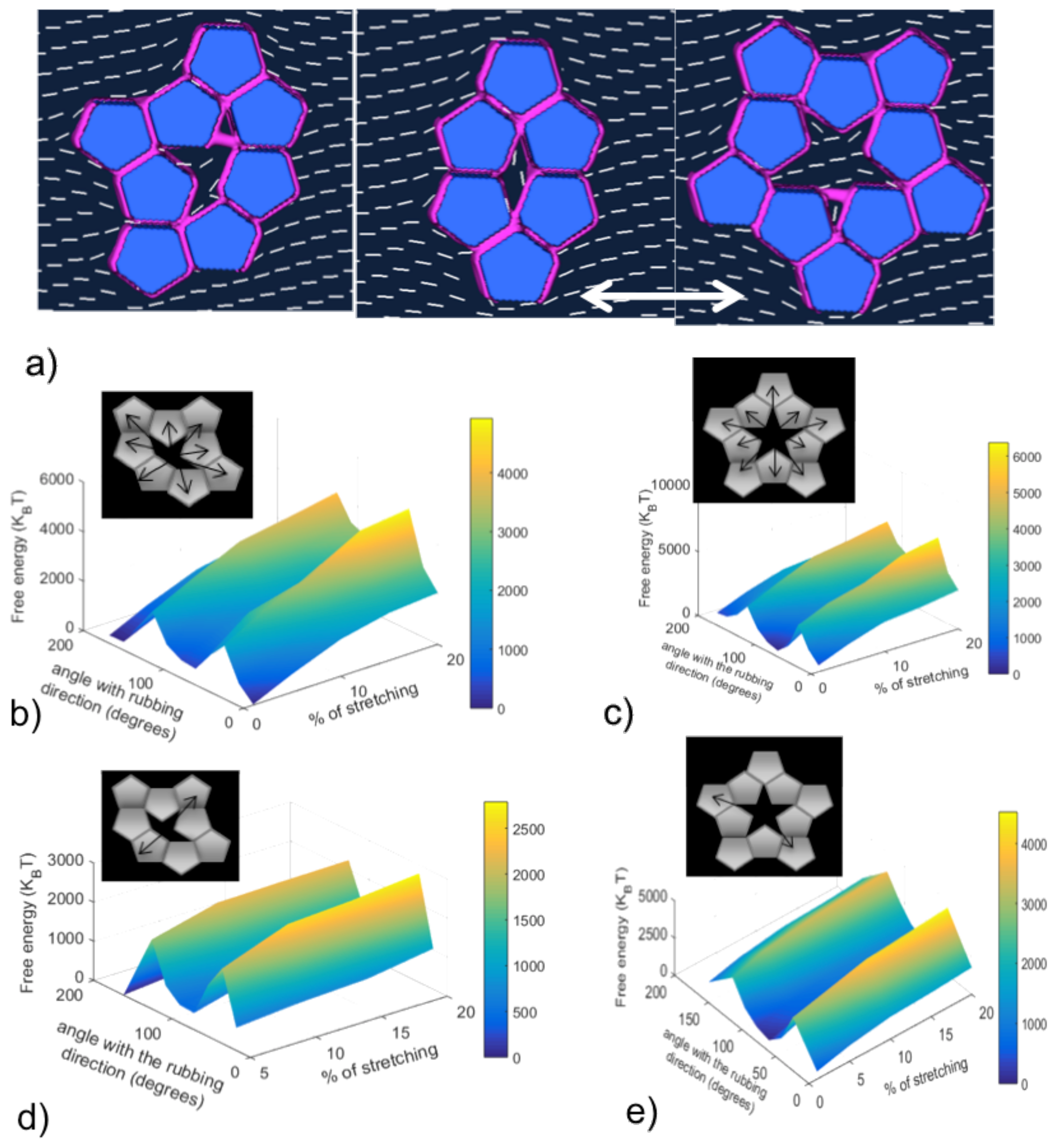
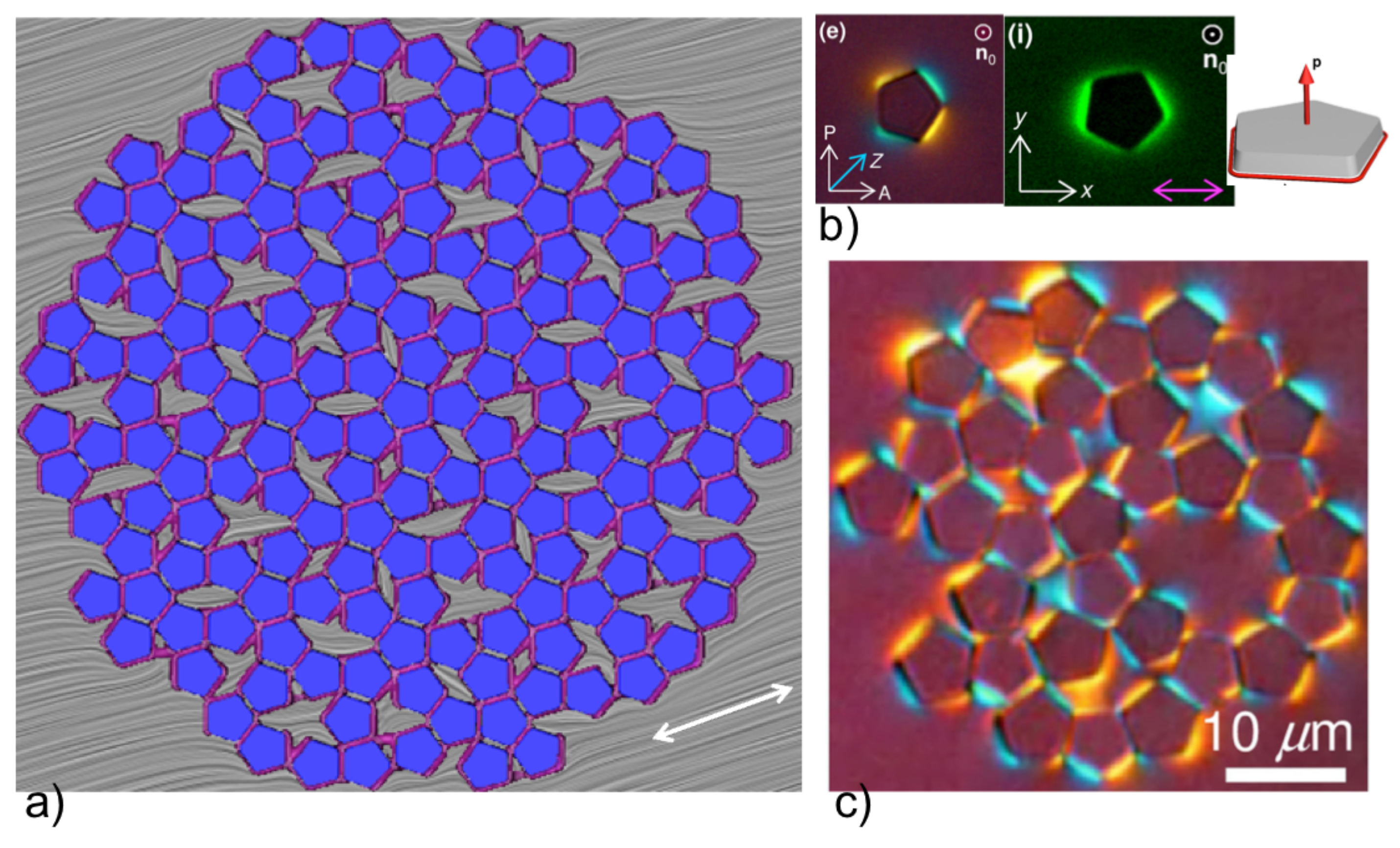
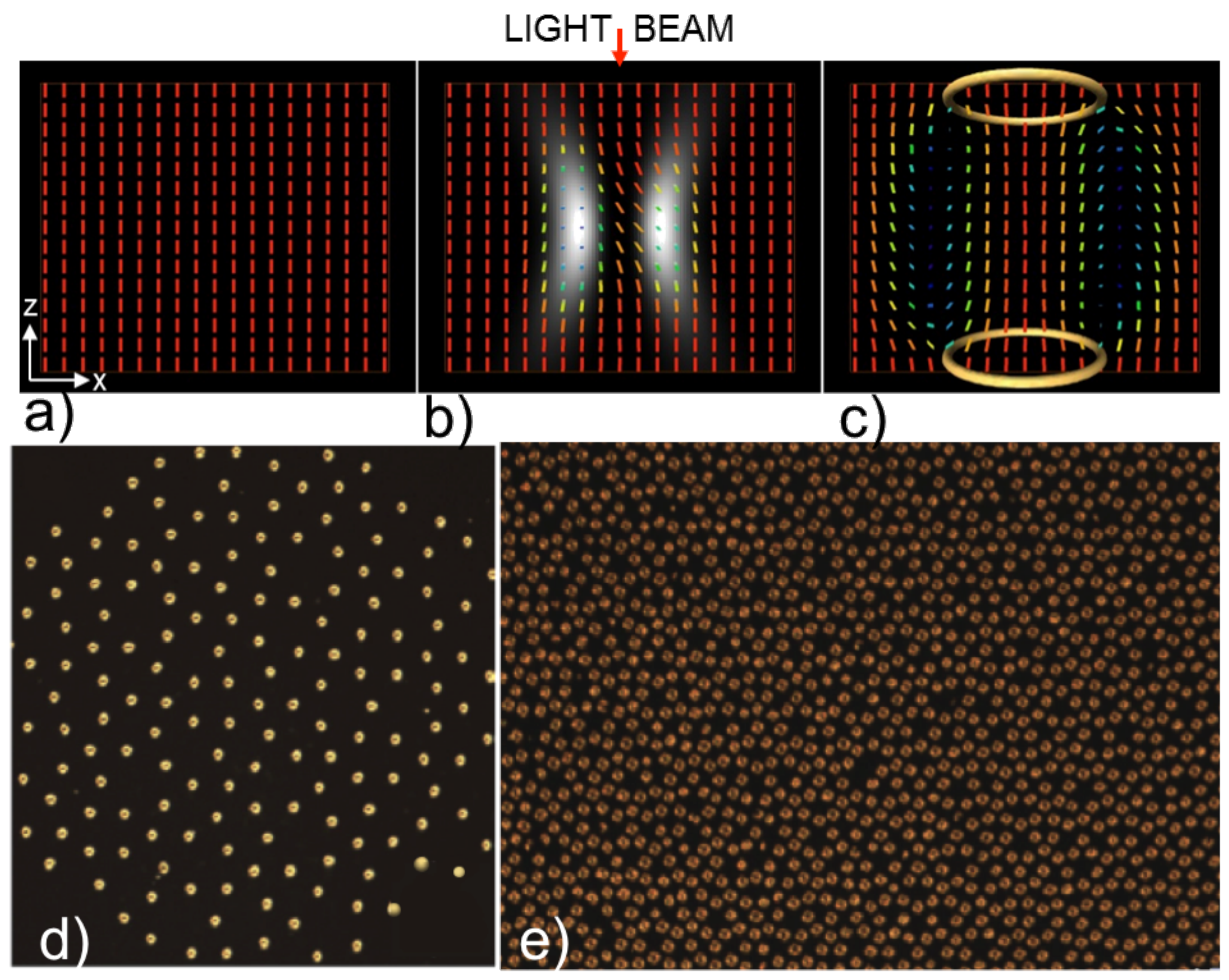
© 2018 by the authors. Licensee MDPI, Basel, Switzerland. This article is an open access article distributed under the terms and conditions of the Creative Commons Attribution (CC BY) license (http://creativecommons.org/licenses/by/4.0/).
Share and Cite
Dontabhaktuni, J.; Ravnik, M.; Zumer, S. Quasicrystalline Ordering in Thin Liquid Crystal Films. Crystals 2018, 8, 275. https://doi.org/10.3390/cryst8070275
Dontabhaktuni J, Ravnik M, Zumer S. Quasicrystalline Ordering in Thin Liquid Crystal Films. Crystals. 2018; 8(7):275. https://doi.org/10.3390/cryst8070275
Chicago/Turabian StyleDontabhaktuni, Jayasri, Miha Ravnik, and Slobodan Zumer. 2018. "Quasicrystalline Ordering in Thin Liquid Crystal Films" Crystals 8, no. 7: 275. https://doi.org/10.3390/cryst8070275
APA StyleDontabhaktuni, J., Ravnik, M., & Zumer, S. (2018). Quasicrystalline Ordering in Thin Liquid Crystal Films. Crystals, 8(7), 275. https://doi.org/10.3390/cryst8070275





